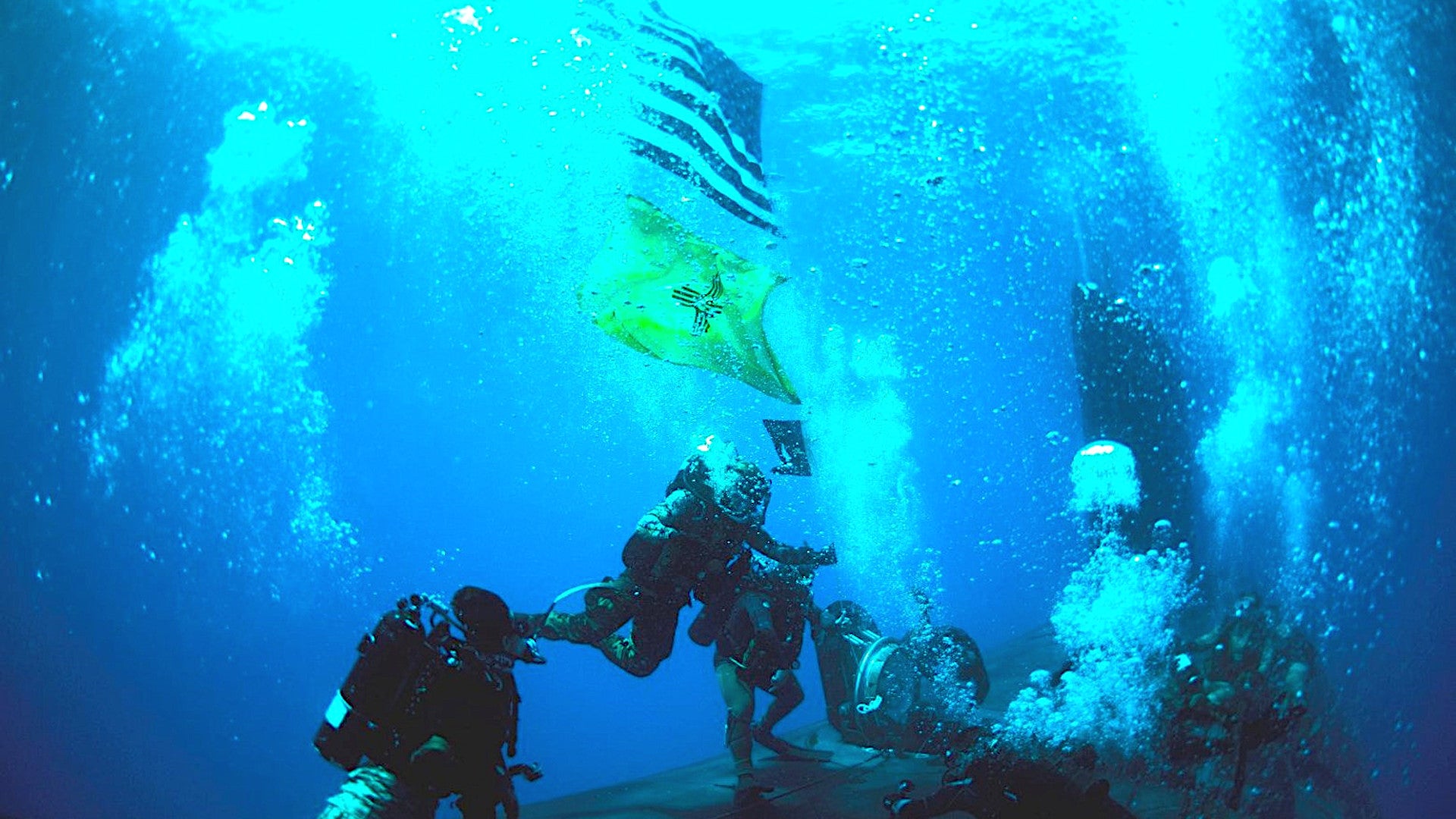The U.S. Navy has released a striking underwater image, seen at the top of this story, of SEALs conducting diving operations training while embarked on the Virginia class attack submarine USS New Mexico in the Mediterranean Sea. Submarines, in general, offer a valuable way to covertly or clandestinely deploy special operations forces, and the Virginia class, in particular, was designed with a number of features to support these missions.
The training event took place in June, but the Navy only released the picture above yesterday. This image shows five individuals, one of which is holding a line with the flags of the United States and the state of New Mexico attached to it, congregating near the exterior hatch to the submerged submarine’s lock-in/lock-out chamber. The Navy had previously released another underwater shot from the drills, seen below, as well as other pictures of the naval special operations forces working with the New Mexico, after the submarine had picked them up in Souda Bay in Greece on June 4, 2021.
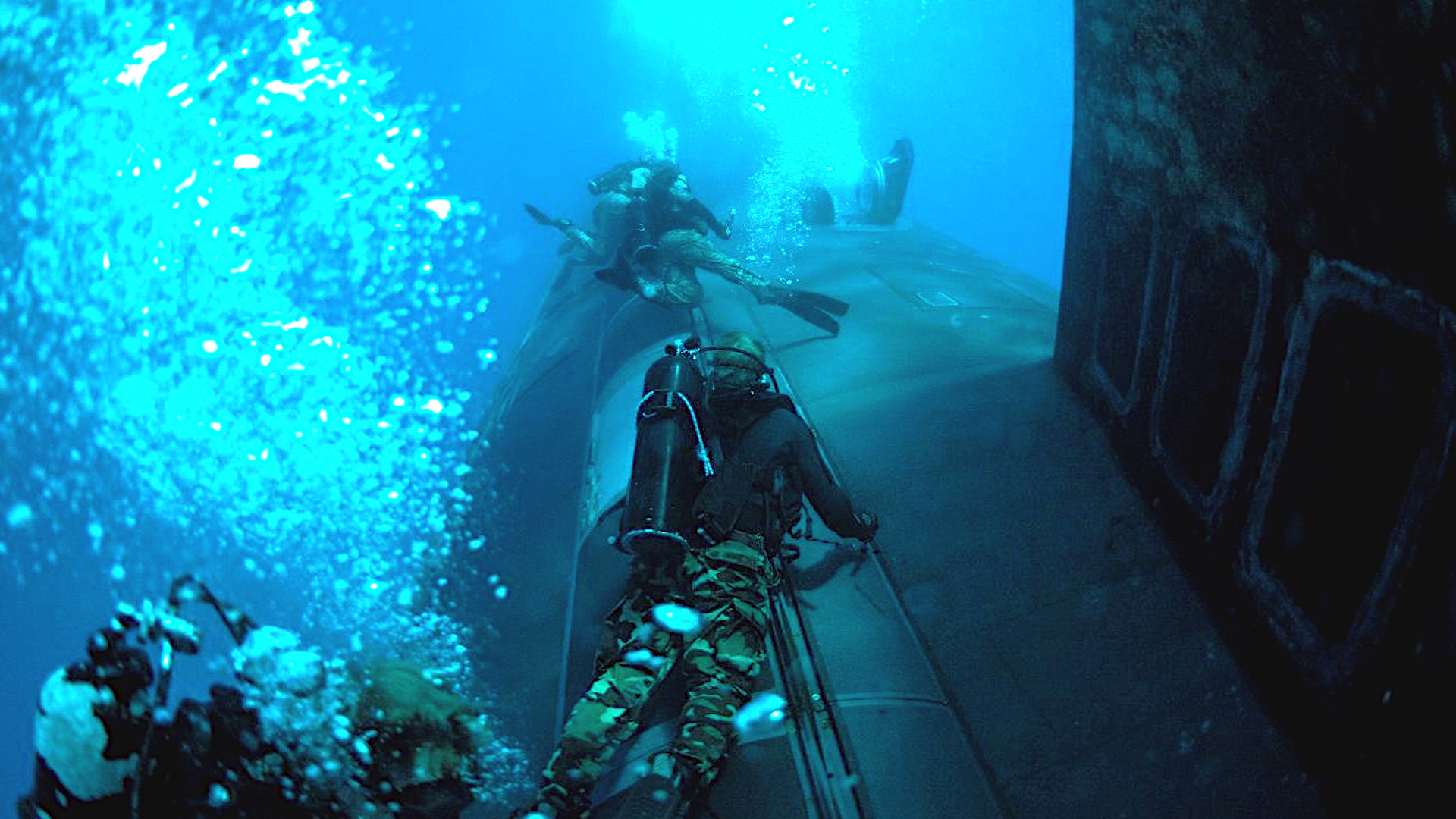
It is worth noting that both the Navy’s submarine forces and the SEALs typically try to keep a very low profile, so highlighting these activities, at all, is notable by itself. This is the latest example of a recent burst of unusually public submarine activity, which service has often publicized officially, around the world, as well.
Interestingly, the Navy also described this particular set of drills as a “milestone event” and a “proof-of-concept in theater” to show how the capabilities that these naval special operators offer could be more readily included in routine submarine operations in the region. However, though the Navy categorizes them as attack submarines, the Virginia class was designed from the outset to have multi-mission capabilities, including the ability to support special operations forces.
A number of these boats are configured specifically for the special operations support mission with a Dry Deck Shelter (DDS) on top of their hulls aft of their sails. The DDSs, like the one seen in use in the Navy Combat Camera video below, allow for the underwater deployment of large payloads, such as miniature submarines and unmanned underwater vehicles (UUV), as well as the simultaneous egress of large groups of combat swimmers.

Even without a DDS fitted, all “Virginia class submarines have special features to support special operations forces (SOF), including a reconfigurable torpedo room which can accommodate a large number of SOF and all their equipment for prolonged deployments and future off-board payloads,” according to the Navy. “The class also has a large lock-in/lock-out chamber for divers.”
Since around 2014, at least, New Mexico has actually been specifically designated as an alternate to the special operations-focused boats with the DDSs installed. Still, this recent drill does underscore how, even without a DDS, Virginia class submarines, in particular, can be rapidly repurposed as underwater launch platforms for special operations forces.
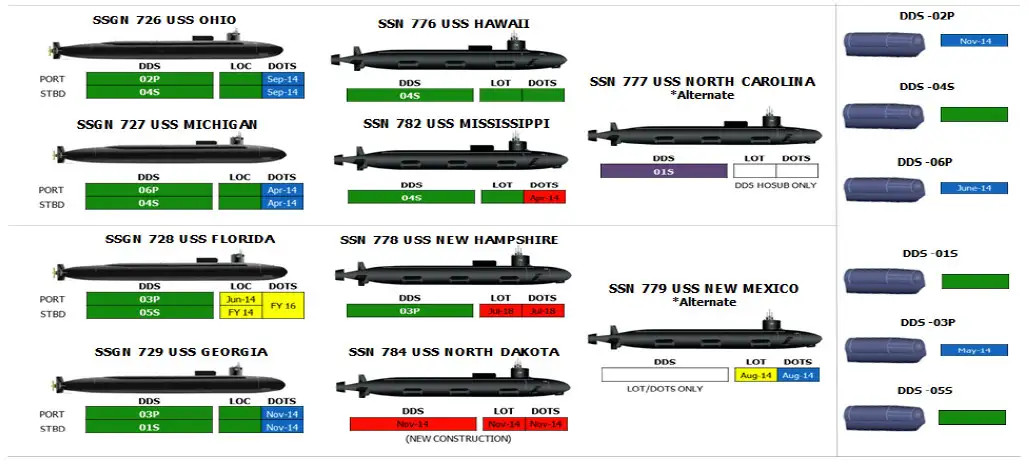
“The combined clandestine capabilities of Naval Special Operations Forces and submarines provide an asymmetric advantage that bolsters the Navy’s lethality from the sea,” U.S. Navy Rear Admiral Anthony Carullo, the Director of Maritime Operations for U.S. Sixth Fleet, which oversees American naval operations in and around Europe and much of Africa, who is also the Commander of Submarine Group 8, said in a statement about the training earlier this month. “This training demonstrated how the submarine force can adapt mission sets for theater commanders, providing a variety of options to address multi-domain challenges.”
“The training between Navy SEALs and USS New Mexico are a real-life demonstration of the capabilities the U.S. military can bring to bear,” U.S. Air Force Major General David Tabor, head of Special Operations Command Europe (SOCEUR), said in a separate statement. “It is important to remember Special Forces do not operate in a vacuum. Close coordination between Special Operations Forces and conventional forces acts as a force multiplier and leverages discreet capabilities to enhance lethality and contributes to dominance on the battlefield.”
The use of submarines to deploy small teams of combat swimmers is, of course, hardly new. As Rear Admiral Anthony Carullo noted, submarines inherently offer a prime way to get special operators where they need to go covertly or clandestinely. This ability to conduct operations discreetly and in contested environments is extremely valuable for staging raids on targets at sea or on land, with special operations forces like the SEALs being able to minimize their chances of detection when traveling to and from their objective.
However, not having the DDS would limit how far away a Virginia class submarine could deploy special operators from their targets. Without a larger swimmer delivery vehicle of some kind, SEALs or other combat swimmers would have to rely on smaller propulsion devices or simply swim the entire distance, which could be extremely taxing on even highly trained personnel.
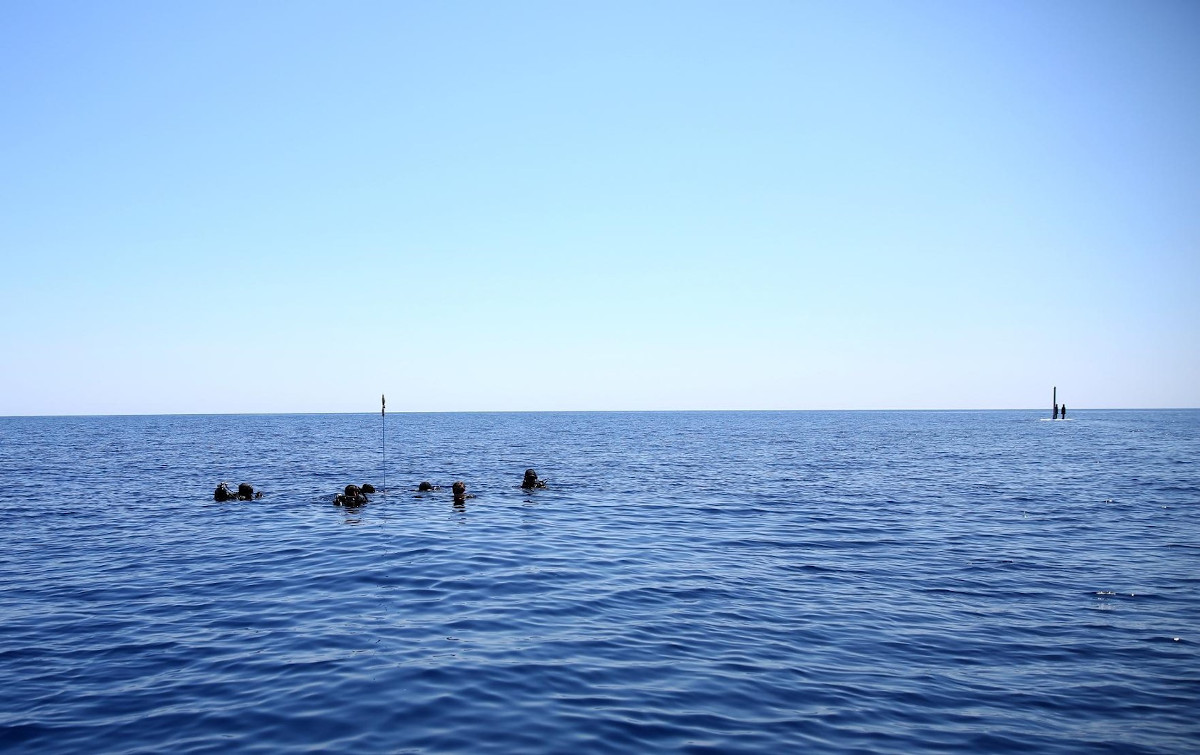
Scuba gear with rebreathers, which it’s not clear if the SEALs were wearing during the training with USS New Mexico, do keep breathing gasses warmer, and therefore makes the entire experience closer to normal breathing, helping to reduce fatigue. They also recycle those gasses, giving individuals more time they can spend underwater, and more range as a result. However, none of this changes the physical stamina required to swim across extended distances underwater, especially if the water temperature is very low. Cold water temperatures can cause fatigue even for individuals riding in swimmer delivery vehicles that are not fully enclosed and this is one of the reasons why the Navy has been developing a new Dry Combat Submersible to at least supplement existing “wet” designs.
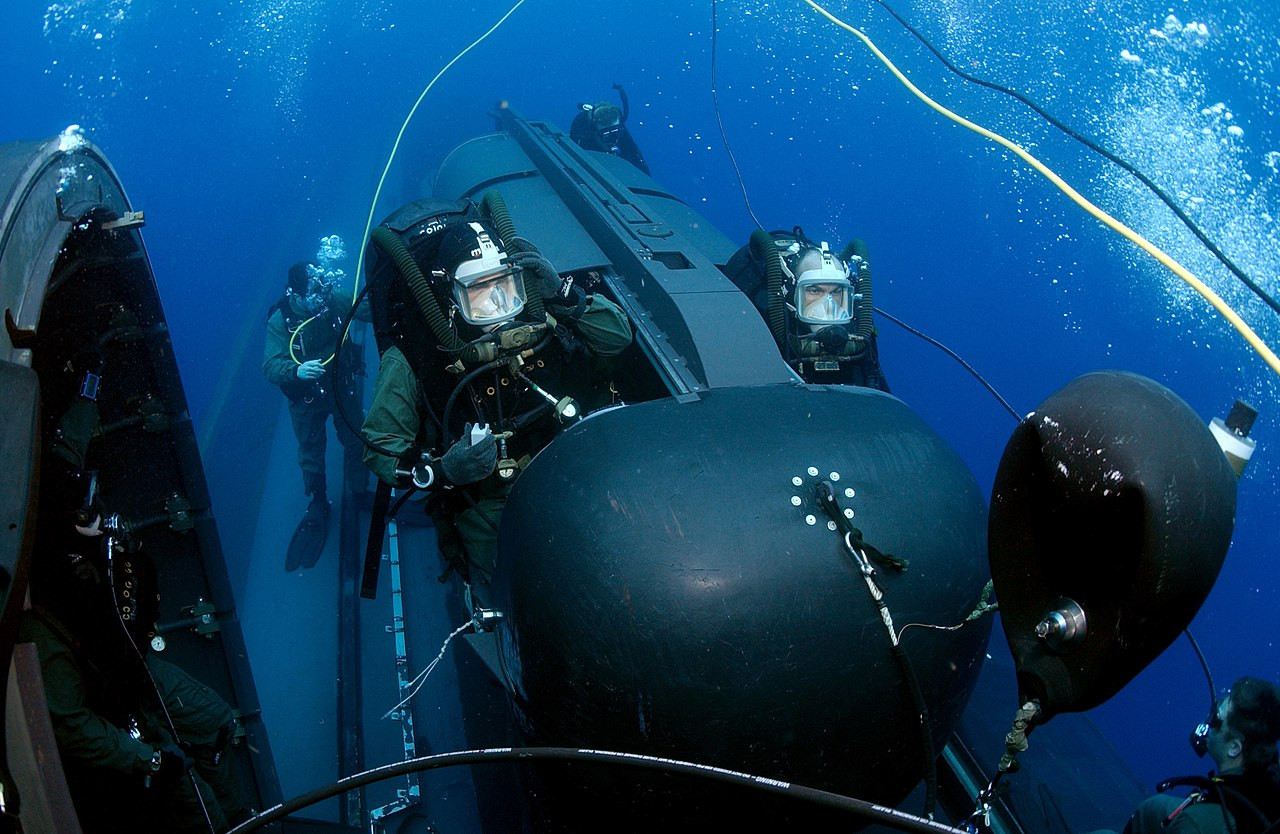
Regardless, training to integrate SEALs, or other special operations forces, such as Scuba-qualified U.S. Army Special Forces teams, into Navy submarine operations on a more routine basis could offer commanders in and around Europe and Africa greater flexibility. Being able to readily embark those special operations elements onto boats at forward locations, such as Souda Bay, would only provide more options during crises and contingencies of various scales.
Training to more regularly use any Virginia class submarine for special operations forces support missions is also valuable given the limited number of boats specifically configured for these tasks, which also include the four Ohio class guided missile submarines. Those converted Ohios, which you can read about in more detail in this past War Zone feature, are in very high demand around the world, but are also extremely low-density assets, which can function as long-range strike platforms, launch pads for special operations forces and unmanned systems, and robust underwater intelligence fusion and command and control centers.
The concepts of operation that the SEALs and the crew of the USS New Mexico demonstration would be applicable elsewhere around the globe, too. However, it’s perhaps not surprising that the Navy chose to publicize this particular training in the Mediterranean, which touches on a number of areas of tension or potential flashpoints, from Syria to the east, the Black Sea to the northeast, and North Africa to the south. The region is a hotbed of submarine and other naval activity, recently both on the part of the Navy, as well as its allies, and potential adversaries, particularly the Russians.
It is, of course, still intriguing that the Navy decision to publicize any of this at all, and it remains to be seen whether more imagery of these kinds of specialized, but very valuable training exercises will continue to be released as time goes on.
Contact the author: joe@thedrive.com
